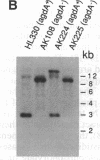Abstract
Introduction of restriction enzyme along with linearized plasmid results in integration of plasmid DNA at genomic restriction sites in a high proportion of the resulting transformants. We have found that electroporating BamHI or EcoRI together with pyr5-6 plasmids cut with the same enzyme stimulates the efficiency of transformation in Dictyostelium discoideum more than 20-fold over the rate seen when plasmid DNA alone is introduced. Restriction enzyme-mediated integration generates insertions into genomic restriction sites in an apparently random manner, some of which cause mutations. About 1 in 400 of the Dictyostelium transformants displayed arrested or aberrant development. The integrated plasmid, along with flanking genomic DNA, was excised from some of these mutants, cloned in Escherichia coli, and used to transform other Dictyostelium cells. Homologous recombination within the flanking sequences resulted in the same phenotypes displayed by the original mutants, directly demonstrating that the affected genes were responsible for the specific morphological phenotypes. This method of insertional mutagenesis should be useful for tagging, and subsequent cloning, of many developmentally important genes that can be identified by their mutant phenotypes.
Full text
PDF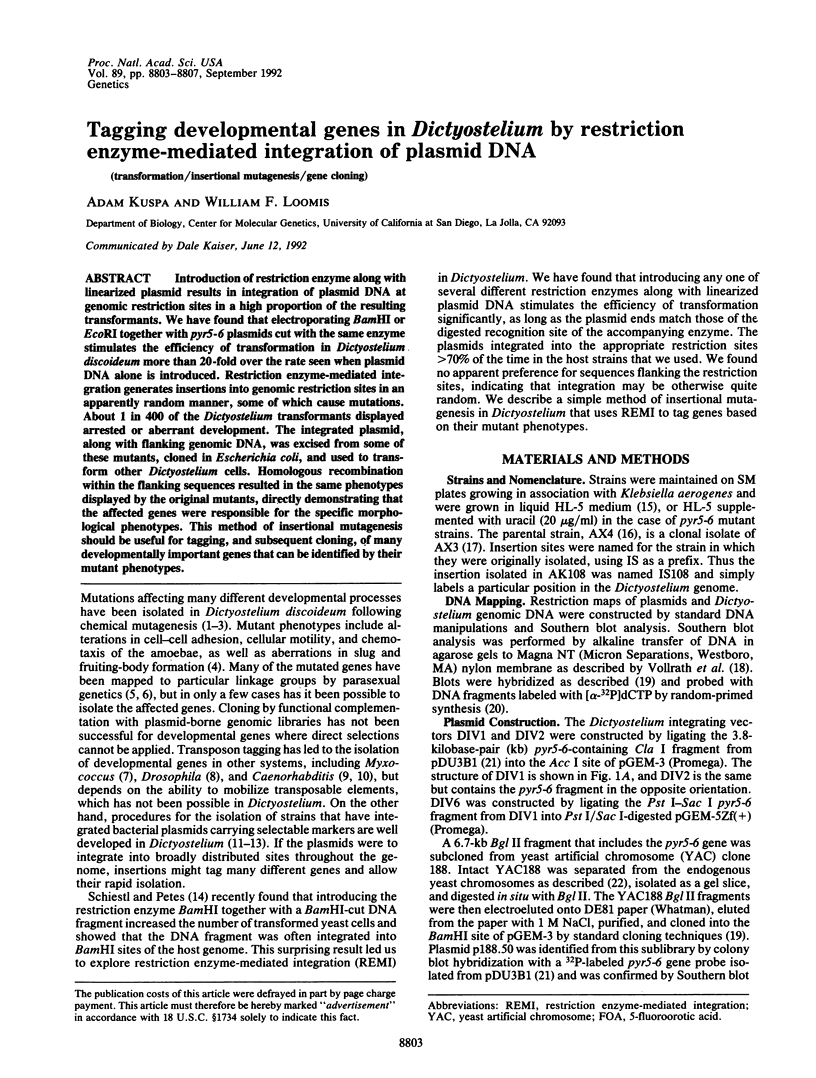
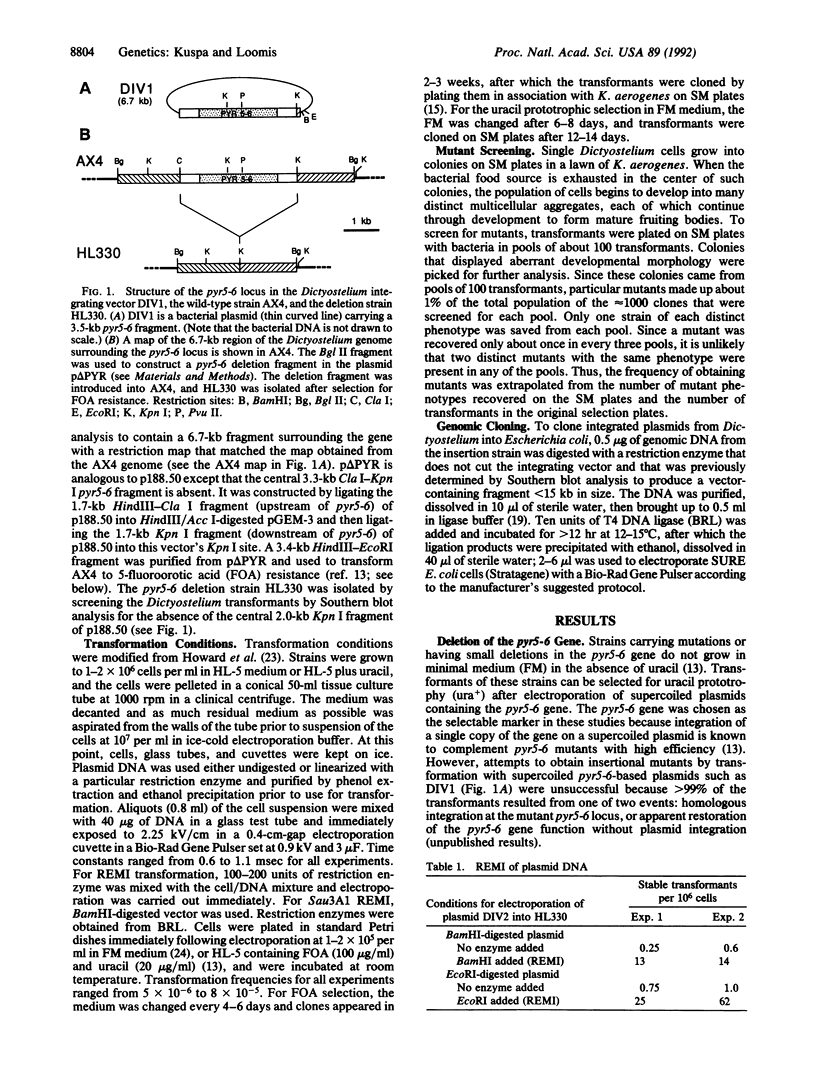
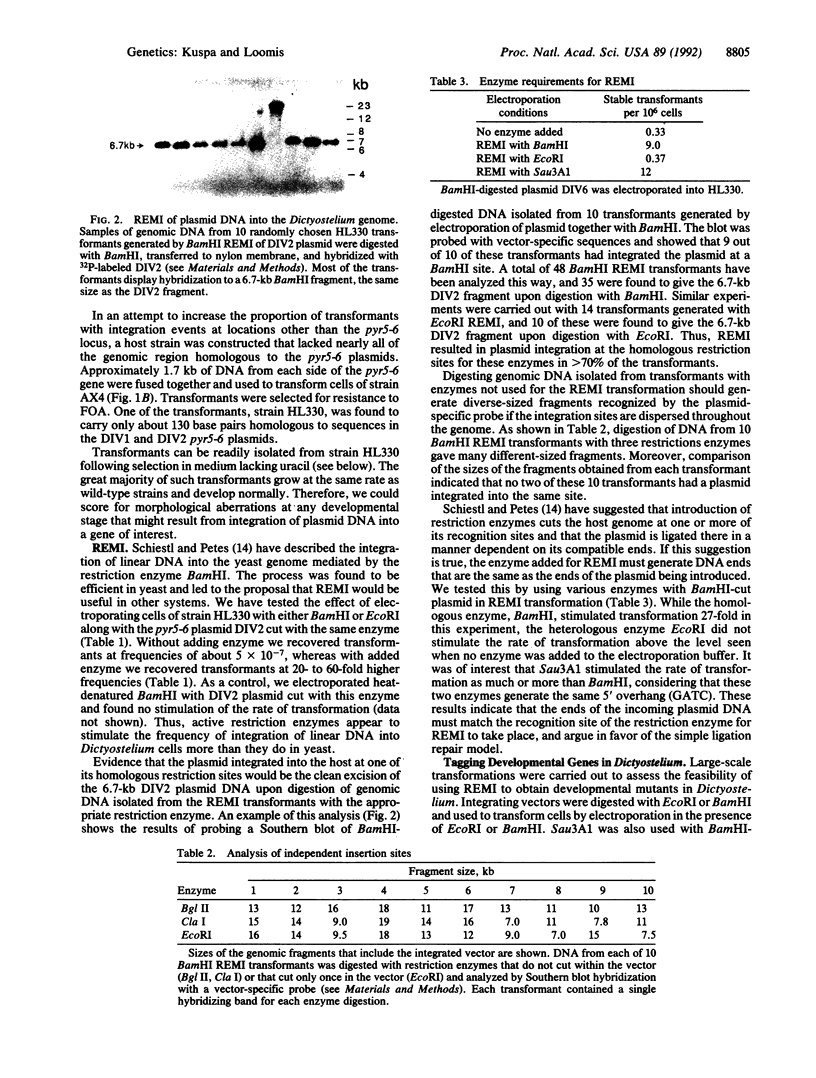

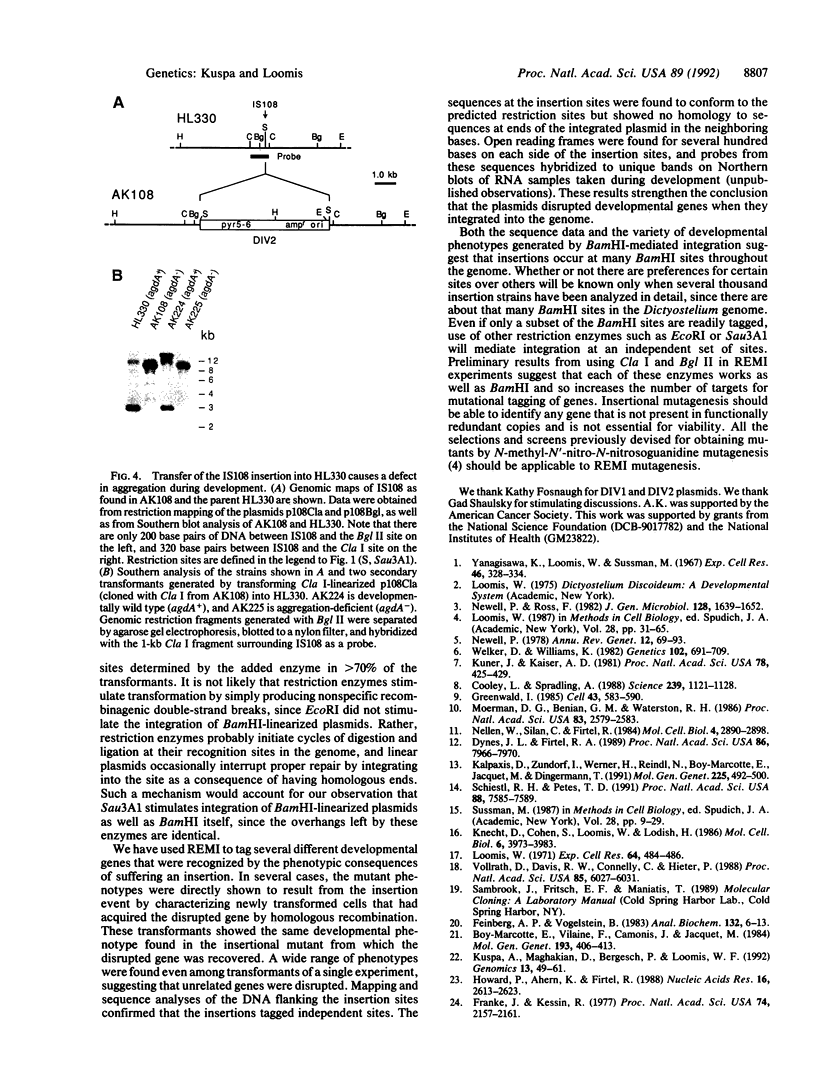
Images in this article
Selected References
These references are in PubMed. This may not be the complete list of references from this article.
- Boy-Marcotte E., Vilaine F., Camonis J., Jacquet M. A DNA sequence from Dictyostelium discoideum complements ura3 and ura5 mutations of Saccharomyces cerevisiae. Mol Gen Genet. 1984;193(3):406–413. doi: 10.1007/BF00382076. [DOI] [PubMed] [Google Scholar]
- Cooley L., Kelley R., Spradling A. Insertional mutagenesis of the Drosophila genome with single P elements. Science. 1988 Mar 4;239(4844):1121–1128. doi: 10.1126/science.2830671. [DOI] [PubMed] [Google Scholar]
- Dynes J. L., Firtel R. A. Molecular complementation of a genetic marker in Dictyostelium using a genomic DNA library. Proc Natl Acad Sci U S A. 1989 Oct;86(20):7966–7970. doi: 10.1073/pnas.86.20.7966. [DOI] [PMC free article] [PubMed] [Google Scholar]
- Feinberg A. P., Vogelstein B. A technique for radiolabeling DNA restriction endonuclease fragments to high specific activity. Anal Biochem. 1983 Jul 1;132(1):6–13. doi: 10.1016/0003-2697(83)90418-9. [DOI] [PubMed] [Google Scholar]
- Franke J., Kessin R. A defined minimal medium for axenic strains of Dictyostelium discoideum. Proc Natl Acad Sci U S A. 1977 May;74(5):2157–2161. doi: 10.1073/pnas.74.5.2157. [DOI] [PMC free article] [PubMed] [Google Scholar]
- Greenwald I. lin-12, a nematode homeotic gene, is homologous to a set of mammalian proteins that includes epidermal growth factor. Cell. 1985 Dec;43(3 Pt 2):583–590. doi: 10.1016/0092-8674(85)90230-2. [DOI] [PubMed] [Google Scholar]
- Howard P. K., Ahern K. G., Firtel R. A. Establishment of a transient expression system for Dictyostelium discoideum. Nucleic Acids Res. 1988 Mar 25;16(6):2613–2623. doi: 10.1093/nar/16.6.2613. [DOI] [PMC free article] [PubMed] [Google Scholar]
- Kalpaxis D., Zündorf I., Werner H., Reindl N., Boy-Marcotte E., Jacquet M., Dingermann T. Positive selection for Dictyostelium discoideum mutants lacking UMP synthase activity based on resistance to 5-fluoroorotic acid. Mol Gen Genet. 1991 Mar;225(3):492–500. doi: 10.1007/BF00261692. [DOI] [PubMed] [Google Scholar]
- Knecht D. A., Cohen S. M., Loomis W. F., Lodish H. F. Developmental regulation of Dictyostelium discoideum actin gene fusions carried on low-copy and high-copy transformation vectors. Mol Cell Biol. 1986 Nov;6(11):3973–3983. doi: 10.1128/mcb.6.11.3973. [DOI] [PMC free article] [PubMed] [Google Scholar]
- Kuner J. M., Kaiser D. Introduction of transposon Tn5 into Myxococcus for analysis of developmental and other nonselectable mutants. Proc Natl Acad Sci U S A. 1981 Jan;78(1):425–429. doi: 10.1073/pnas.78.1.425. [DOI] [PMC free article] [PubMed] [Google Scholar]
- Kuspa A., Maghakian D., Bergesch P., Loomis W. F. Physical mapping of genes to specific chromosomes in Dictyostelium discoideum. Genomics. 1992 May;13(1):49–61. doi: 10.1016/0888-7543(92)90201-3. [DOI] [PubMed] [Google Scholar]
- Loomis W. F. Genetic tools for Dictyostelium discoideum. Methods Cell Biol. 1987;28:31–65. doi: 10.1016/s0091-679x(08)61636-2. [DOI] [PubMed] [Google Scholar]
- Loomis W. F., Jr Sensitivity of Dictyostelium discoideum to nucleic acid analogues. Exp Cell Res. 1971 Feb;64(2):484–486. doi: 10.1016/0014-4827(71)90107-8. [DOI] [PubMed] [Google Scholar]
- Moerman D. G., Benian G. M., Waterston R. H. Molecular cloning of the muscle gene unc-22 in Caenorhabditis elegans by Tc1 transposon tagging. Proc Natl Acad Sci U S A. 1986 Apr;83(8):2579–2583. doi: 10.1073/pnas.83.8.2579. [DOI] [PMC free article] [PubMed] [Google Scholar]
- Nellen W., Silan C., Firtel R. A. DNA-mediated transformation in Dictyostelium discoideum: regulated expression of an actin gene fusion. Mol Cell Biol. 1984 Dec;4(12):2890–2898. doi: 10.1128/mcb.4.12.2890. [DOI] [PMC free article] [PubMed] [Google Scholar]
- Newell P. C. Genetics of the cellular slime molds. Annu Rev Genet. 1978;12:69–93. doi: 10.1146/annurev.ge.12.120178.000441. [DOI] [PubMed] [Google Scholar]
- Schiestl R. H., Petes T. D. Integration of DNA fragments by illegitimate recombination in Saccharomyces cerevisiae. Proc Natl Acad Sci U S A. 1991 Sep 1;88(17):7585–7589. doi: 10.1073/pnas.88.17.7585. [DOI] [PMC free article] [PubMed] [Google Scholar]
- Sussman M. Cultivation and synchronous morphogenesis of Dictyostelium under controlled experimental conditions. Methods Cell Biol. 1987;28:9–29. doi: 10.1016/s0091-679x(08)61635-0. [DOI] [PubMed] [Google Scholar]
- Vollrath D., Davis R. W., Connelly C., Hieter P. Physical mapping of large DNA by chromosome fragmentation. Proc Natl Acad Sci U S A. 1988 Aug;85(16):6027–6031. doi: 10.1073/pnas.85.16.6027. [DOI] [PMC free article] [PubMed] [Google Scholar]
- Welker D. L., Williams K. L. A genetic map of Dictyostelium discoideum based on mitotic recombination. Genetics. 1982 Dec;102(4):691–710. doi: 10.1093/genetics/102.4.691. [DOI] [PMC free article] [PubMed] [Google Scholar]
- Yanagisawa K., Loomis W. F., Jr, Sussman M. Developmental regulation of the enzyme UDP-galactose polysaccharide transferase. Exp Cell Res. 1967 May;46(2):328–334. doi: 10.1016/0014-4827(67)90070-5. [DOI] [PubMed] [Google Scholar]




